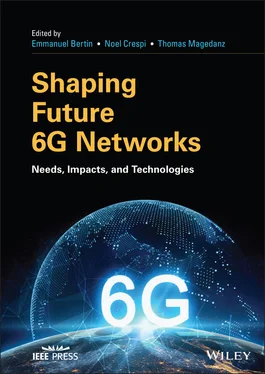Shaping Future 6G Networks
Здесь есть возможность читать онлайн «Shaping Future 6G Networks» — ознакомительный отрывок электронной книги совершенно бесплатно, а после прочтения отрывка купить полную версию. В некоторых случаях можно слушать аудио, скачать через торрент в формате fb2 и присутствует краткое содержание. Жанр: unrecognised, на английском языке. Описание произведения, (предисловие) а так же отзывы посетителей доступны на портале библиотеки ЛибКат.
- Название:Shaping Future 6G Networks
- Автор:
- Жанр:
- Год:неизвестен
- ISBN:нет данных
- Рейтинг книги:3 / 5. Голосов: 1
-
Избранное:Добавить в избранное
- Отзывы:
-
Ваша оценка:
- 60
- 1
- 2
- 3
- 4
- 5
Shaping Future 6G Networks: краткое содержание, описание и аннотация
Предлагаем к чтению аннотацию, описание, краткое содержание или предисловие (зависит от того, что написал сам автор книги «Shaping Future 6G Networks»). Если вы не нашли необходимую информацию о книге — напишите в комментариях, мы постараемся отыскать её.
Discover the societal and technology drivers contributing to build the next generation of wireless telecommunication networks Shaping Future 6G Networks: Needs, Impacts, and Technologies
Shaping Future 6G Networks
Shaping Future 6G Networks — читать онлайн ознакомительный отрывок
Ниже представлен текст книги, разбитый по страницам. Система сохранения места последней прочитанной страницы, позволяет с удобством читать онлайн бесплатно книгу «Shaping Future 6G Networks», без необходимости каждый раз заново искать на чём Вы остановились. Поставьте закладку, и сможете в любой момент перейти на страницу, на которой закончили чтение.
Интервал:
Закладка:
Marco Giordani1, Michele Polese2, Andres Laya3, Emmanuel Bertin4, and Michele Zorzi1
1Department of Information Engineering, University of Padova, Padova, Italy
2Institute for the Wireless Internet of Things, Northeastern University, Boston, MA, USA
3Ericsson Research, Stockholm, Sweden
4Orange Innovation, France
2.1 Introduction
The 5th generation (5G) of wireless networks was positioned to support, besides the evolution of mobile broadband, new use cases ranging from massive IoT to ultrareliable services. However, in view of future technological innovations, researchers, industrial companies, and standardization bodies have started proposing new use cases and services that, for their generality and complementarity, would not be fully supported by 5G networks and are thus good representatives of future 6G services [1]. While the literature has a larger focus on application domains for the business‐to‐consumer (B2C) sector, this chapter discusses new beyond‐5G drivers for the business‐to‐business (B2B) markets, such as automotive, manufacturing and logistics, health and government, smart transportation, banking, and financial verticals.
Starting from the 5G‐identified verticals, we make the case that, among other services, 6G will (i) fully realize the industrial and manufacturing revolution started with 5G, i.e. the digital transition to a cyber physical facility ( Section 2.3.1); (ii) revolutionize business meetings and events by enabling the digitalization and transmission of human sensing and objects through teleportation and digital twins ( Sections 2.3.2and 2.3.3); (iii) support smart (and autonomous) transportation with important implications for the logistics and fleet management sectors ( Section 2.3.4); (iv) improve public safety (PS) networking for first responders ( Section 2.3.5); (v) transform the healthcare sector through remote intervertions and home care to guarantee the most efficient use of healthcare resources and support the reduction of management costs for health facilities ( Section 2.3.6); (vi) accelerate the adoption of solutions for digital services in cities, farming, and warehousing, targeting environmental monitoring, traffic control, and management automation ( Section 2.3.7); and (vii) revolutionize the financial sector by supporting novel banking operations and efficient high‐frequency trading (HFT) ( Section 2.3.8).
This chapter also discusses commonalities and differences among these drivers and outlines the order of magnitude of key performance indicators (KPIs) and requirements to be satisfied. In particular, while 5G‐based use cases typically present trade‐offs on latency, energy consumption, development and deployment costs, computational complexity, and throughput, 6G will be developed to meet stringent network demands in a holistic fashion, in view of the foreseen economic and business context of the 2030 era. Specifically, 6G paradigms will need to support (i) continuous connectivity, thus enabling coverage expansion compared to 5G in a cost‐efficient way to simultaneously reach high capacity, lower latency, and improved reliability; (ii) zero‐energy devices, e.g. for Internet of Things (IoT) and sensing applications for devices dispersed in wide areas for which replacing batteries will not be practical; and (iii) network‐compute integration to allow better predictions while maximizing performance in terms of latencies under 1 millisecond, low jitter, and high communication resilience.
2.2 Relevance of the B2B market for 6G
First generations of mobile communication networks have mainly targeted the B2C market. Offers targeting the B2B market have been mostly limited to providing connectivity to enterprise employees and providing connectivity to manufactured objects. While the first one has been present since the beginning of mobile communications with resource management offers, the second one has appeared progressively with the rise of Machine‐to‐Machine (M2M) communications, e.g., for logistics and traceability purposes. However, these use cases used to be quite marginal in the mobile network operator business, which remained focused on delivering connectivity and providing communication means to the mass market.
5G has been a first move to complement the B2C model. The B2B market has been identified from the beginning as an important driver for 5G services, especially through ultra‐reliable low latency communications (URLLC) and massive machine type communication (mMTC) features. The deployment models of 5G have also been designed to fit enterprise needs. First, 5G standards enable the provision of end‐to‐end network slices targeting specific enterprise needs, covering both radio access network and core network. Second, some industry players are going further and have deployed their own 5G private networks, fully dedicated to their specific needs.
It is expected that 6G will amplify this trend, and that B2B market needs will be a strong driver towards 6G 1 . Our societies indeed rely more and more on digital services and on ambient connectivity. Until now, these digital services have been mainly provided by Internet players (i.e., platforms and content providers), while mobile network operators are providing connectivity to this Internet of services. However, when moving forward in the course of digitalization, social activities and business processes will be progressively transformed. Companies and public organizations will then become key players to implement and benefit from this transformation, and the future 6G requirements should therefore be driven by their pain points and use cases. This also implies a greater involvement of B2B verticals in the 6G standardization process, as outlined in the following chapters of this book.
In the 6G era, innovative mobile network operators will reap benefits from several business models simultaneously: besides selling connectivity services to end‐users, telecommunication operators will provide the required connectivity resources to B2B players (including companies, cities, public authorities, etc.) to fulfill their own missions. Connectivity solutions will need to be flexible enough to adapt to more and more heterogeneous Quality of Service (QoS) requirements, along the lines of what 5G is offering with network slicing. We illustrate this point in the following sections by providing relevant KPIs for the described use cases in the B2B market. 6G should therefore be an opportunity for industry players to invent and design new devices and networking strategies to support their own digital transformation needs of processes and social activities.
2.3 Use Cases for the B2B Market
This section reviews the characteristics and requirements of envisioned 6G use cases for the B2B market, as summarized in Table 2.1.
Table 2.1 6G use cases for the B2B market.
| Use case | Section | Description | Impact for B2B market | Relevant KPIs |
|---|---|---|---|---|
| Industry and manufacturing | 2.3.1 | Digital transformation of manufacturing through cyber physical systems and IoT services | Efficient mining activitiesWide area monitoring of pipelinesBetter precision and coordination for cooperative maneuvers | ReliabilityLatencySpectrum efficiency |
| Teleportation | 2.3.2 | Holographic delivery of life‐sized three‐dimensional stereoscopic experiences in real‐time without HMD technologies | Stimulate teleworkDecrease travel time and expensesImprove labor productivity | Per‐user data ratePeak data rateLatency |
| Digital twin | 2.3.3 | Digital replica of an object inheriting the same behavior and characteristics of the real object | Improve the design, engineering, inspection, and maintenance of complex machines and devicesAllow advanced simulations of the product behavior | Per‐user data ratePeak data rateLatency |
| Smart transportation | 2.3.4 | Evolution of automotive industry to support infotainment, automated driving, and cooperative and intelligent transportation | Preemptive logisticsFleet management and telematicsReduction of goods transportation costs and environmental impact | Spectrum efficiencyPer‐user data rateContinuous coverageVehicle speedNumber of devicesEnergy efficiency |
| Public safety | 2.3.5 | Collection of services that support fast delivery of information between emergency operators in incident areas and the (remote) command station | Real‐time 3D rendering of the incident area to/from the command stationRemote control operations | ReliabilityLatencySpectrum efficiencyVehicle speedContinuous coverage |
| Health and well‐being | 2.3.6 | Evolution of healthcare to support telemedicine, healthcare workflow optimizations, and efficient and affordable patient access to health assistance | Individualized assistance via virtual patient consultation and monitoring involving all senses and health indicatorsEfficient use of healthcare resources through preventive care, digitalization, and access to massive dataReduction of management and administration costs through “care outside hospital” paradigm | ReliabilityLatencySpectrum efficiency |
| Smart‐X IoT | 2.3.7 | IoT and smart city paradigms targeting life quality improvements, environmental monitoring, traffic control, and city management automation | Efficient agriculture and farmingFleet managementSmart warehouse managementSupport of zero‐energy sensors for home appliances, industrial machines, and robots | Spectrum efficiencyPer‐user data rateNumber of devicesEnergy efficiency |
| Financial world | 2.3.8 | Evolution of financial sector through high‐frequency trading and blockchain technology | More accessible tradingElevated security and reduced fees for banking transactionsRobust/secure fraud preventionTransition toward digital banking | LatencyReliability |
2.3.1 Industry and Manufacturing
Интервал:
Закладка:
Похожие книги на «Shaping Future 6G Networks»
Представляем Вашему вниманию похожие книги на «Shaping Future 6G Networks» списком для выбора. Мы отобрали схожую по названию и смыслу литературу в надежде предоставить читателям больше вариантов отыскать новые, интересные, ещё непрочитанные произведения.
Обсуждение, отзывы о книге «Shaping Future 6G Networks» и просто собственные мнения читателей. Оставьте ваши комментарии, напишите, что Вы думаете о произведении, его смысле или главных героях. Укажите что конкретно понравилось, а что нет, и почему Вы так считаете.












